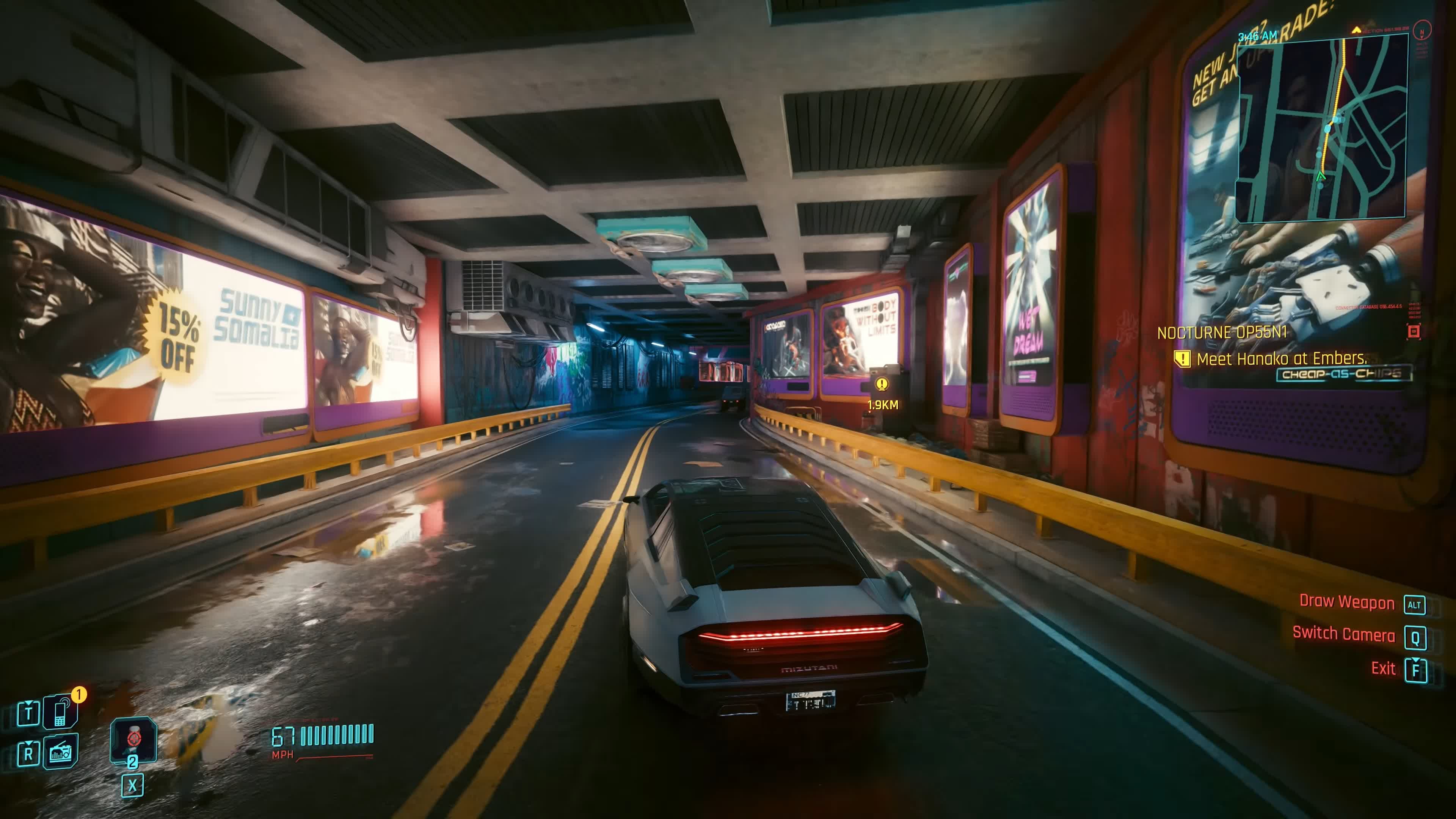The next iteration of Nvidia’s DLSS technology has landed and today we’re checking out what DLSS 3.5 is and more specifically, take a closer look at its new ray reconstruction feature.
The new tech has been integrated into Cyberpunk 2077 2.0 which launched this week ahead of the Phantom Liberty expansion, and we’ve been spending some time with it over the last week or so to see how well DLSS 3.5 works.
TL;DR: What is ray reconstruction and why is it an important upgrade?
Ray tracing effects in today’s games are noisy, because running these effects at a higher quality level would cripple current graphics cards. To fight and remove this image noise, developers implement denoising filters, which do help this noise but come with a host of other issues, like ghosting, lower levels of detail, and various inaccuracies.
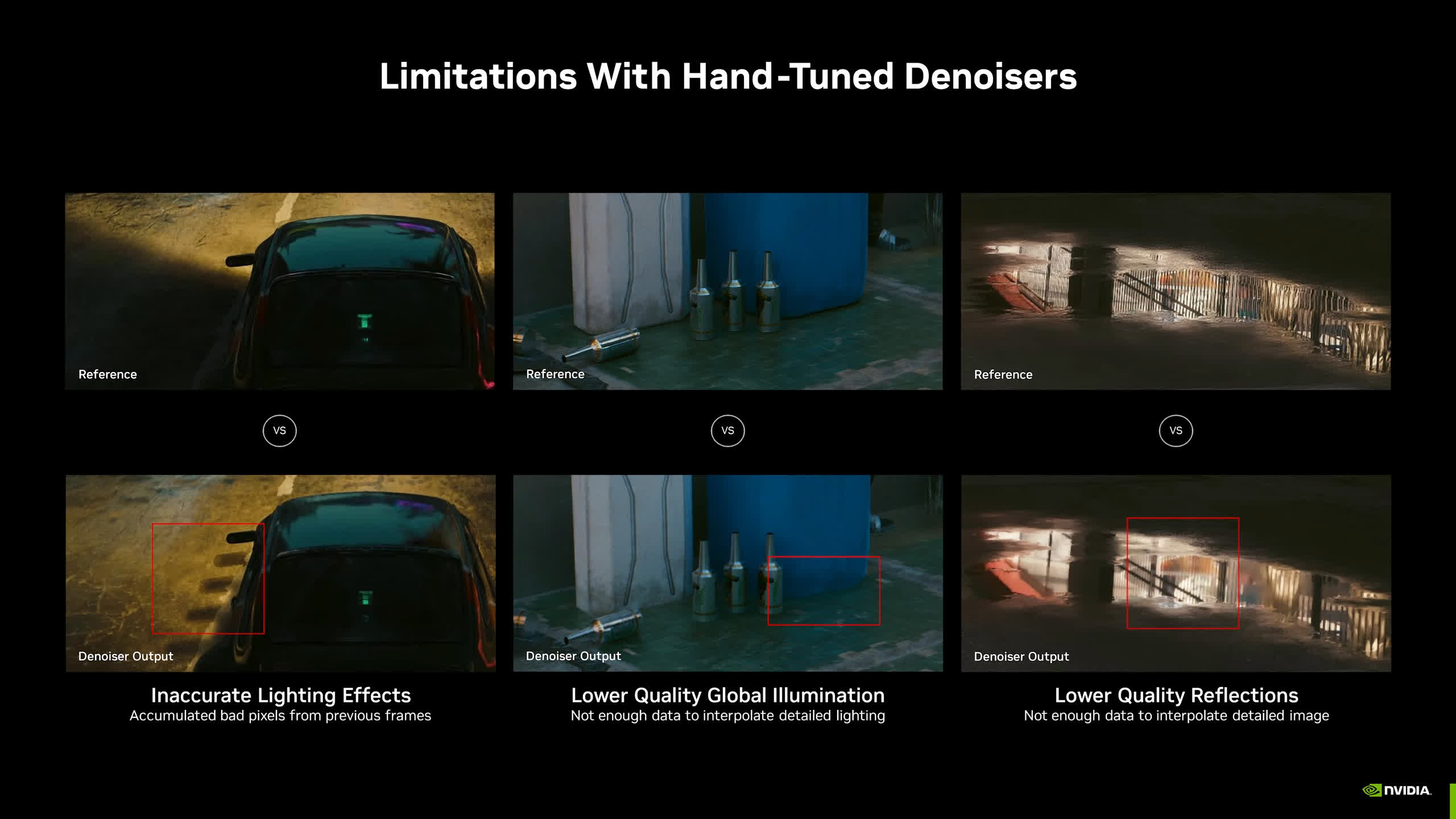
Ray reconstruction replaces the game’s denoiser with a DLSS AI-enhanced denoiser that promises greater quality and fewer artifacts than standard denoisers. It achieves this by combining the upscaling and denoising passes into the one algorithm, effectively replacing DLSS Super Resolution with a combined DLSS ray reconstruction and Super Resolution algorithm. Like existing DLSS techniques, it requires game engine inputs as seen in this diagram.
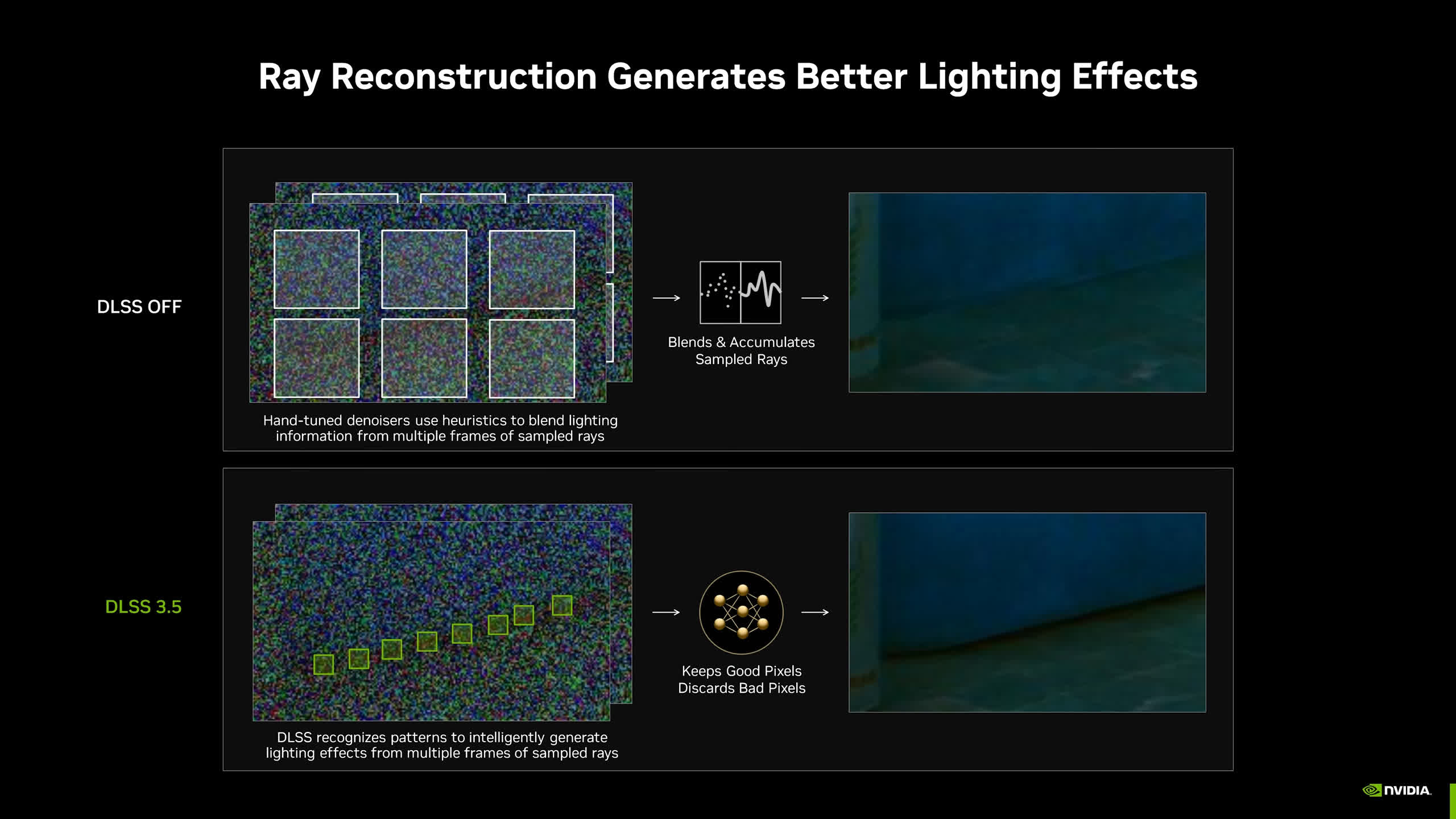
DLSS 3.5 ray reconstruction is trained to not only provide upscaling reconstruction from a lower pixel count image, but ray tracing effect reconstruction from a low ray count image, too.
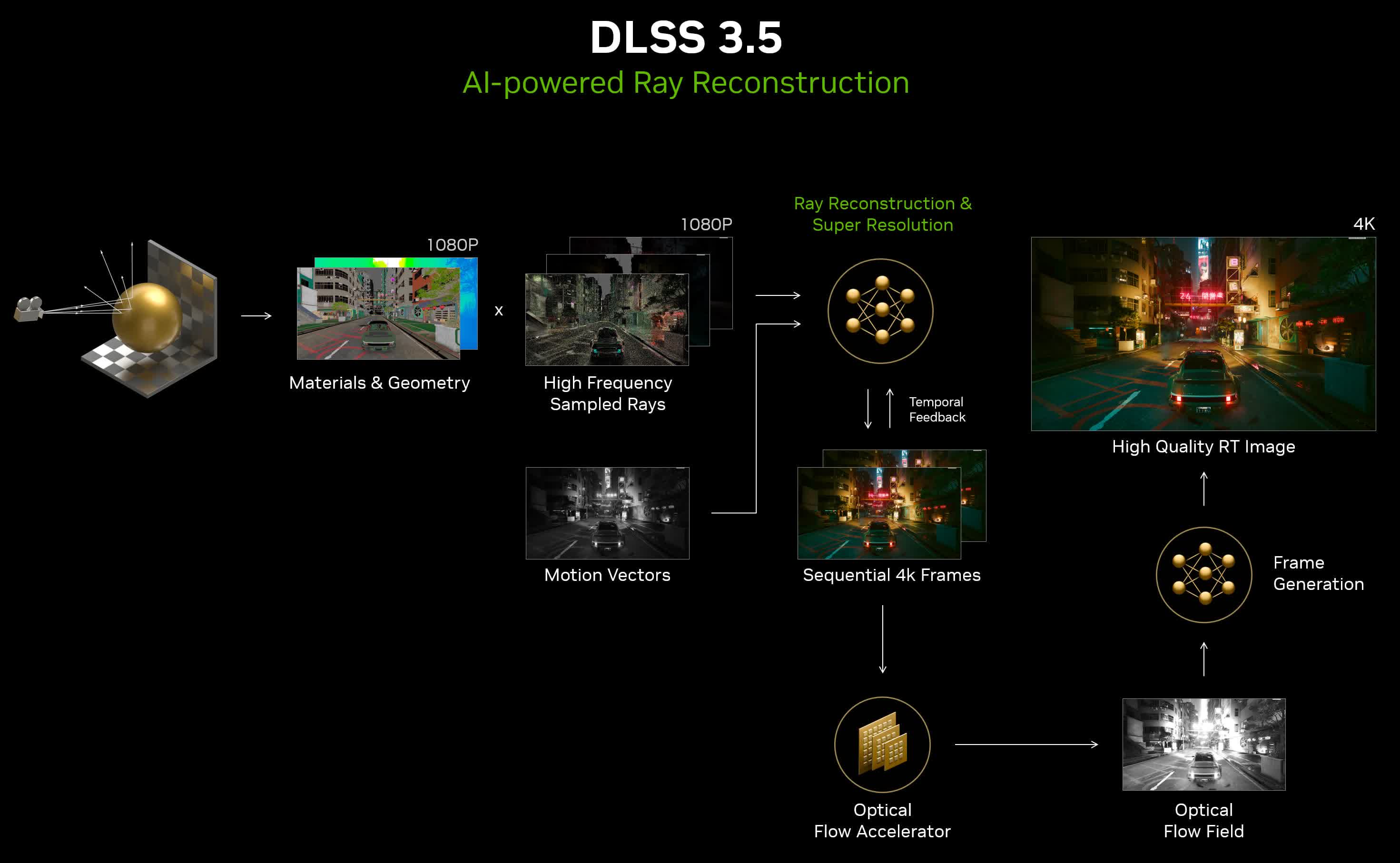
As ray reconstruction replaces the standard Super Resolution algorithm with a combined version, it must be used with Super Resolution enabled, but Nvidia believes this will deliver an overall superior image at very little cost to performance relative to playing with traditional denoisers and only Super Resolution.
DLSS 3.5 could have been named better
In our opinion, DLSS 3.5 is confusingly named. When DLSS was first launched, it referred only to Nvidia’s upscaling technology, “Deep Learning Super Sampling.” Nvidia has since changed this to refer to their collection of AI rendering technologies, so what used to be DLSS and DLSS 2.0 is now DLSS Super Resolution.
Then, with the launch of GeForce RTX 40 series GPUs, they’ve added in Frame Generation to the DLSS family, and now we’re getting ray reconstruction as well.
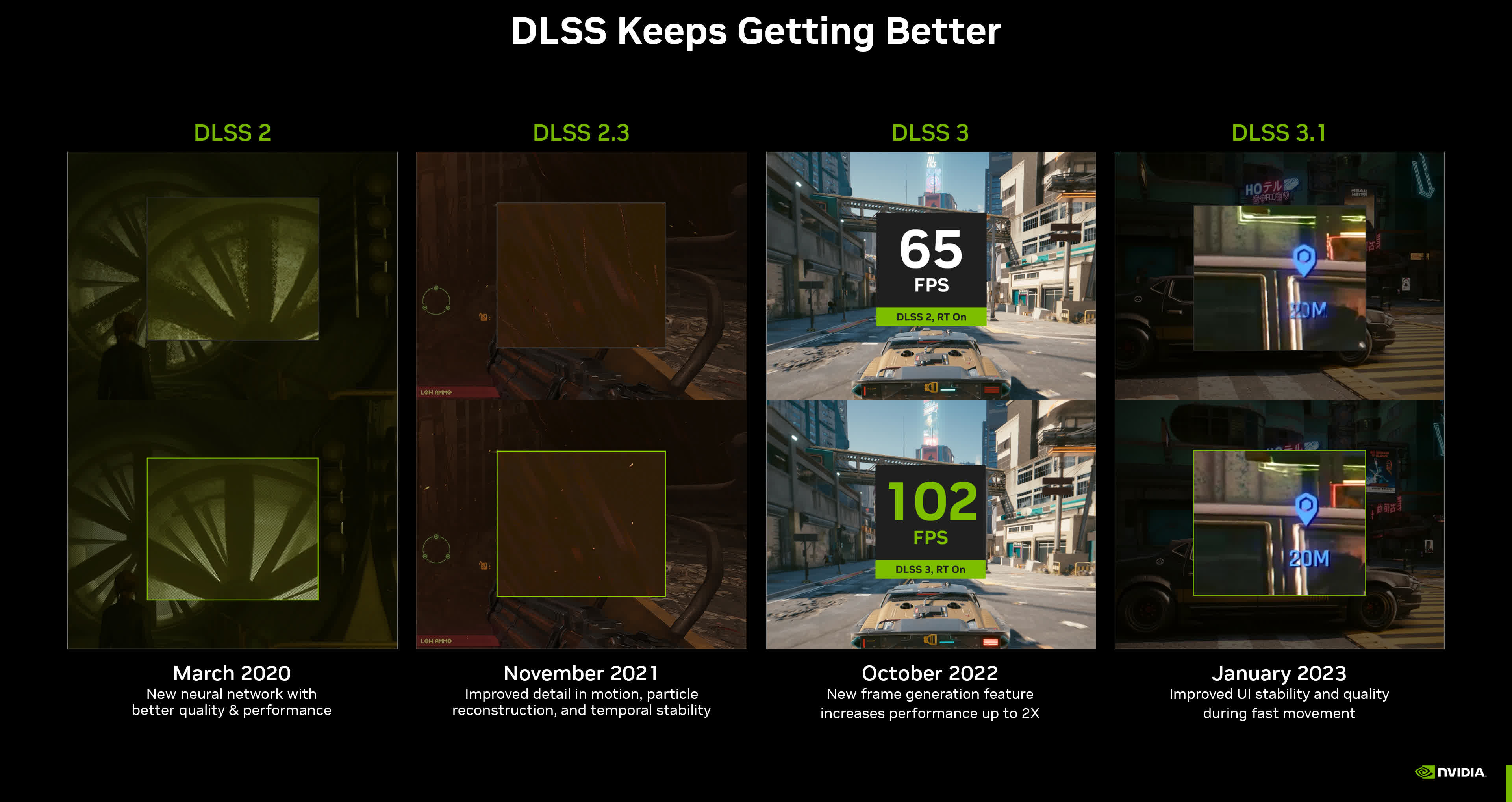
Each of these additions has led to a new DLSS version number: 3.0 for Frame Gen, 3.5 for ray reconstruction. Staying with us so far? Good…
On top of this, each DLSS technology has its own version number. So with DLSS 3.5, Nvidia has added ray reconstruction, and updated both Super Resolution and Frame Generation to version 3.5. Game developers are free to choose whatever technologies they like.
Cyberpunk 2077, for example, has been updated to use DLSS 3.5 but only for the ray reconstruction part; Super Resolution is still on version 3.1.1, and Frame Generation is on 3.1.13. Similarly, there will be games that use DLSS 3.5 Super Resolution, but don’t integrate ray reconstruction. Still with us?
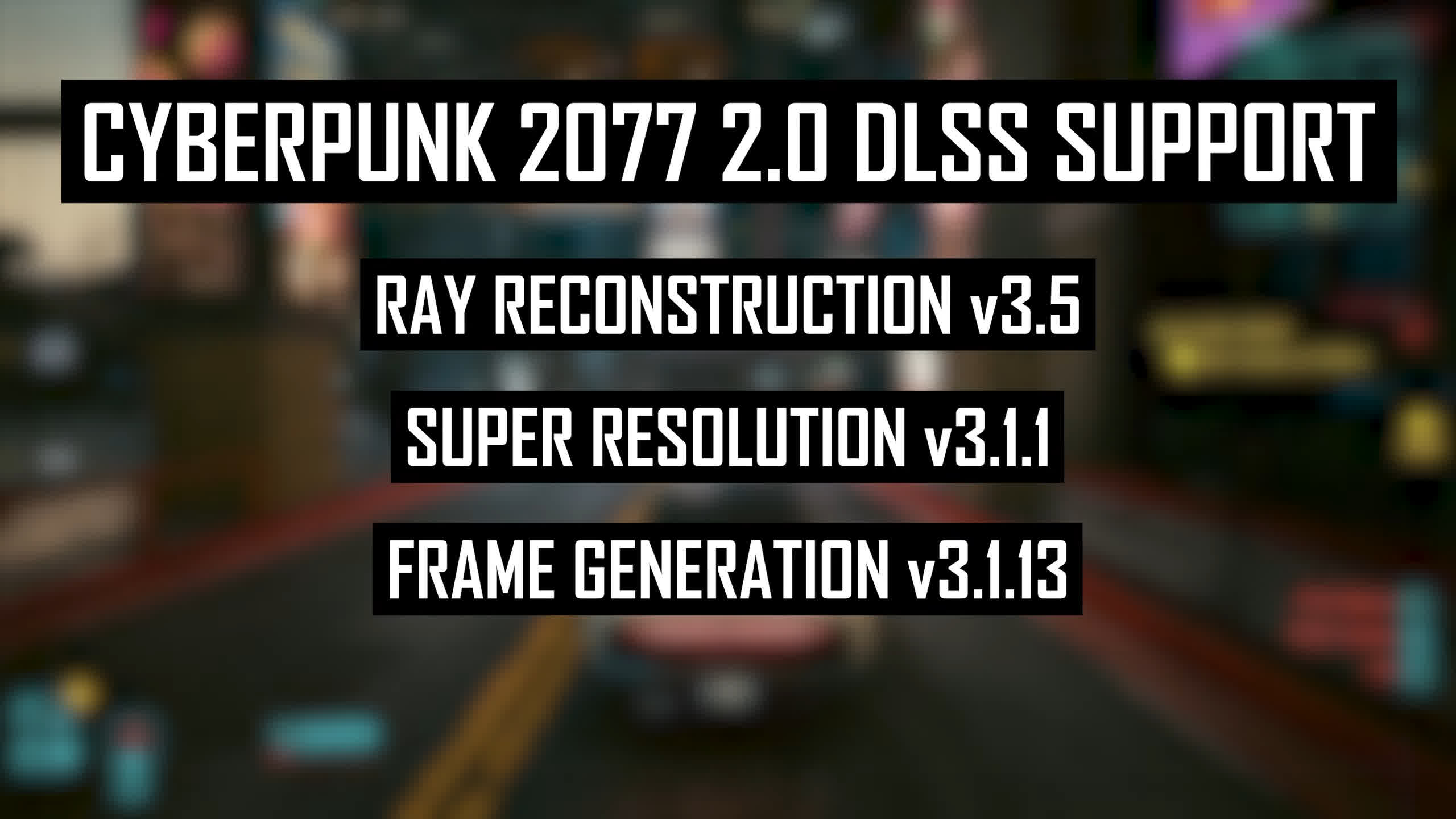
To make sure that gamers definitely can’t follow all of this, DLSS 3.5 ray reconstruction works on all RTX GPUs. But not all of DLSS 3.5 works on all RTX GPUs: Frame Generation is still exclusive to RTX 40 series products.
Considering that Nvidia spent a lot of time marketing DLSS 3 as an exclusive to RTX 40 cards, it’s a bit weird to have DLSS 3.5’s main new feature working on older RTX cards.
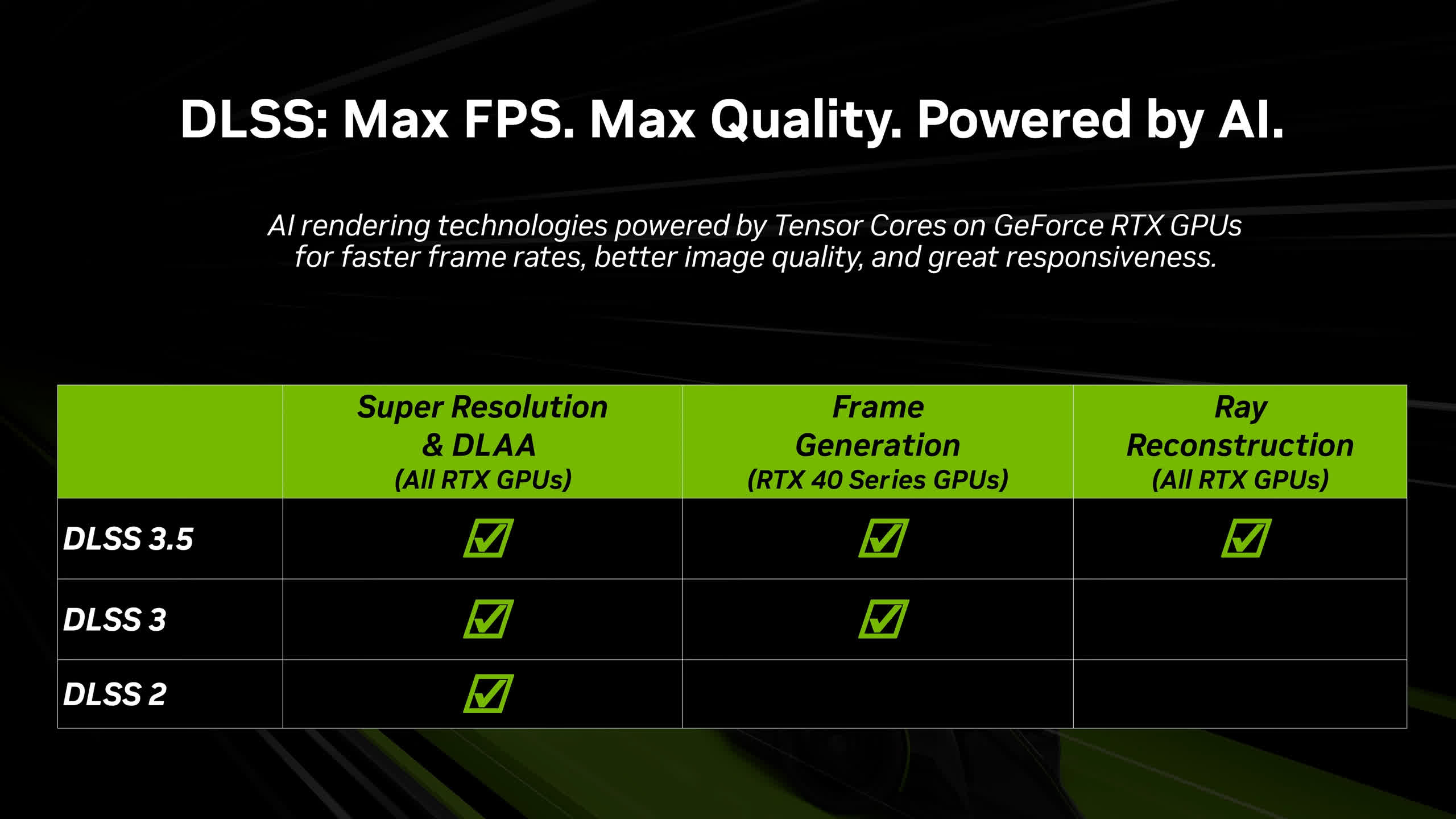
But don’t get us wrong, it’s great that ray reconstruction is available to the vast majority of current GeForce owners, but surely there was a better way to name all of this.
Can DLSS Render “Better Than Native” Graphics?
We’re confident that at some point RTX 30 series owners, for example, won’t understand that their card doesn’t support DLSS 3 Frame Generation but does support DLSS 3.5 ray reconstruction.
Early limitations of ray reconstruction in Cyberpunk 2077
Moving on, having tested ray reconstruction in Cyberpunk, it’s clear that this is an early stage technology that’s effectively a preview of what is (hopefully) to come. It’s hard to draw too many overarching conclusions from seeing it in just one game, but ray reconstruction does have some immediately obvious limitations.
Ray reconstruction is only trained to be used with DLSS upscaling enabled, not DLAA (Deep Learning Anti-Aliasing), so you can’t use both simultaneously, just like you can’t use ray reconstruction without any form of DLSS Super Resolution. Nvidia says they are working on training ray reconstruction to be used with DLAA and that will eventually be supported.
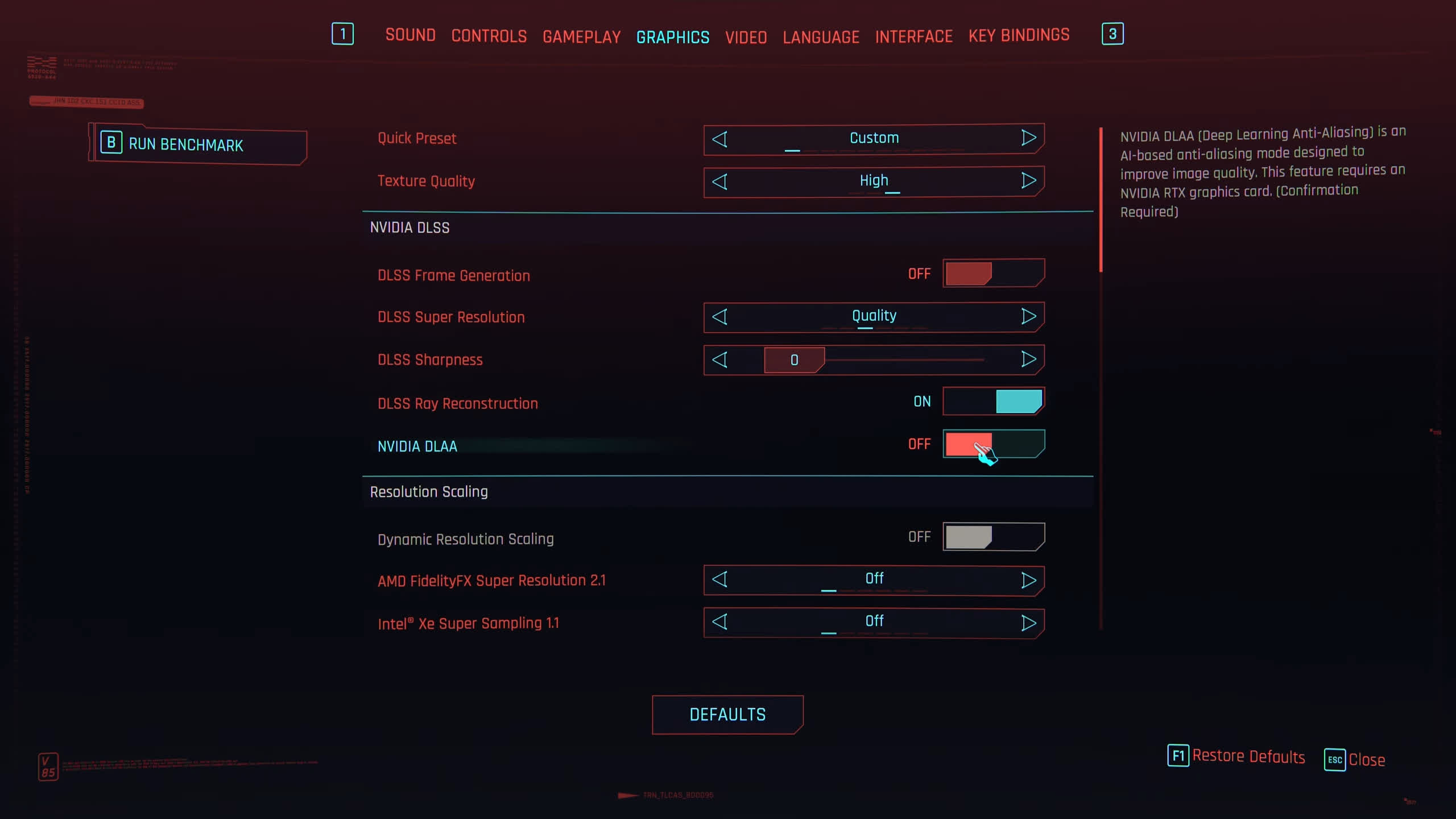
But the bigger limitation is that ray reconstruction is only available when using Cyberpunk’s path tracing mode, a.k.a. RT Overdrive mode. It cannot be enabled when using the game’s regular and less taxing ray tracing effects. Nvidia told us this is an intentional restriction, at least for now. They “focused [their] efforts to make RT Overdrive look great in Cyberpunk 2077, and [are] working with CD Projekt to add support for ray reconstruction for other RT modes.”
We suspect this is because the first version of ray reconstruction has only been optimized for path traced effects and needs optimization work for regular ray tracing. We don’t know this for sure, and Nvidia does claim DLSS 3.5 has been trained on 5x more data than DLSS 3 and recognizes different RT effects.
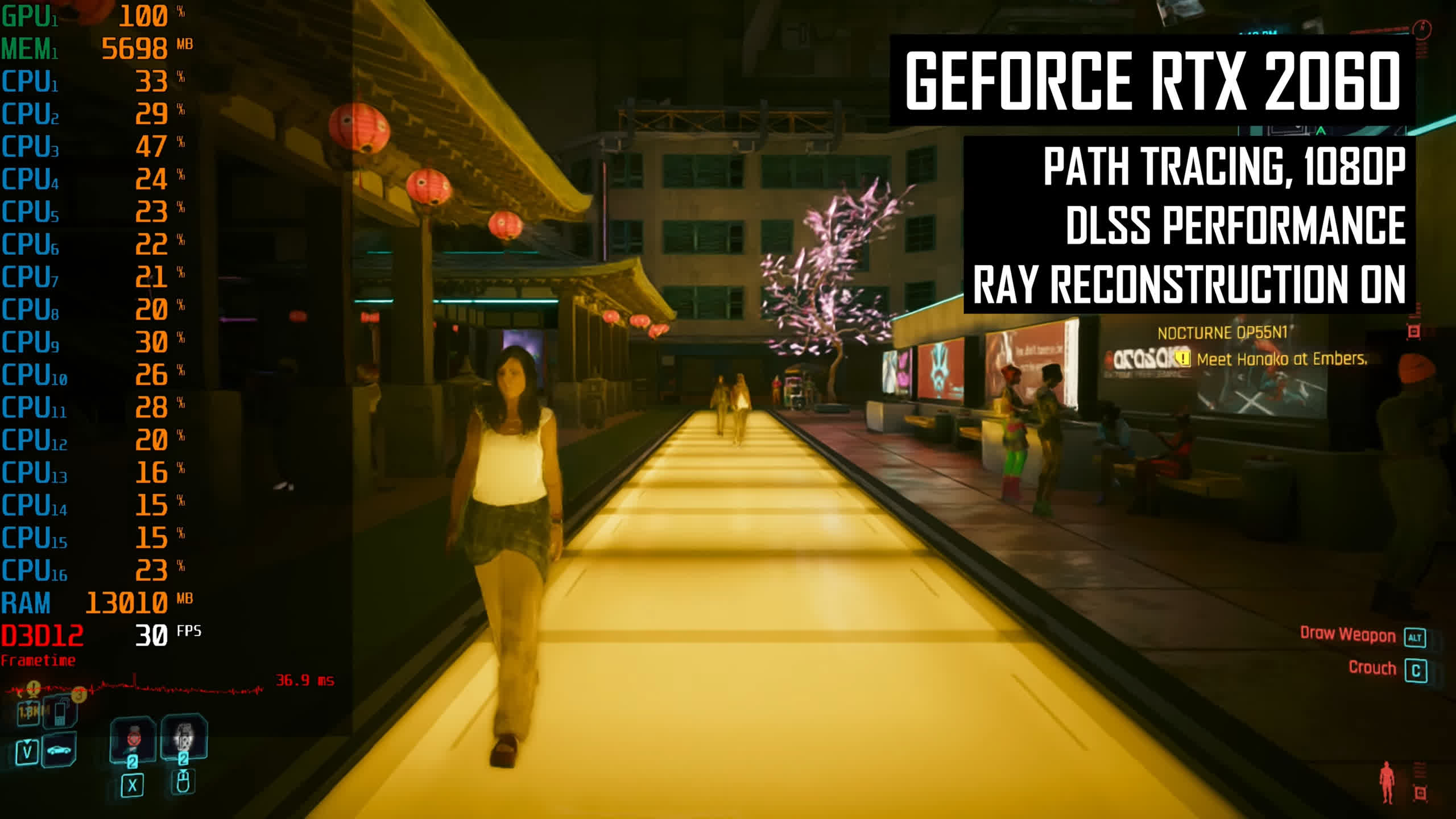
This is a bit disappointing for most GeForce RTX GPU owners because the path traced mode in Cyberpunk is punishing on GPU hardware. Unless you have a high-end GPU like an RTX 4090 or RTX 4080, it’s hard to achieve acceptable performance using RT Overdrive even at lower resolutions like 1080p.
So while it’s nice that DLSS 3.5 does work on lower tier RTX GPUs, practically speaking, someone with something like an RTX 3060 is not going to be using it – at least for now. That’s why it would have been nice to see ray reconstruction available for use with the regular RT effects that are more playable on mid-tier GPUs.
Ray reconstruction visual analysis
So how does ray reconstruction impact the visual quality of Cyberpunk 2077’s path tracing mode? There’s areas of improvement and there are areas that are the same. Watch the video below for a full breakdown.
We recorded gameplay using an Asus ROG Strix GeForce RTX 4090 on a Ryzen 7 7800X3D test system, setting the image quality to 4K on ultra, path tracing enabled, DLSS Quality mode, and no frame generation unless otherwise specified.
For a better representation of image quality comparisons, check out the HUB video below:
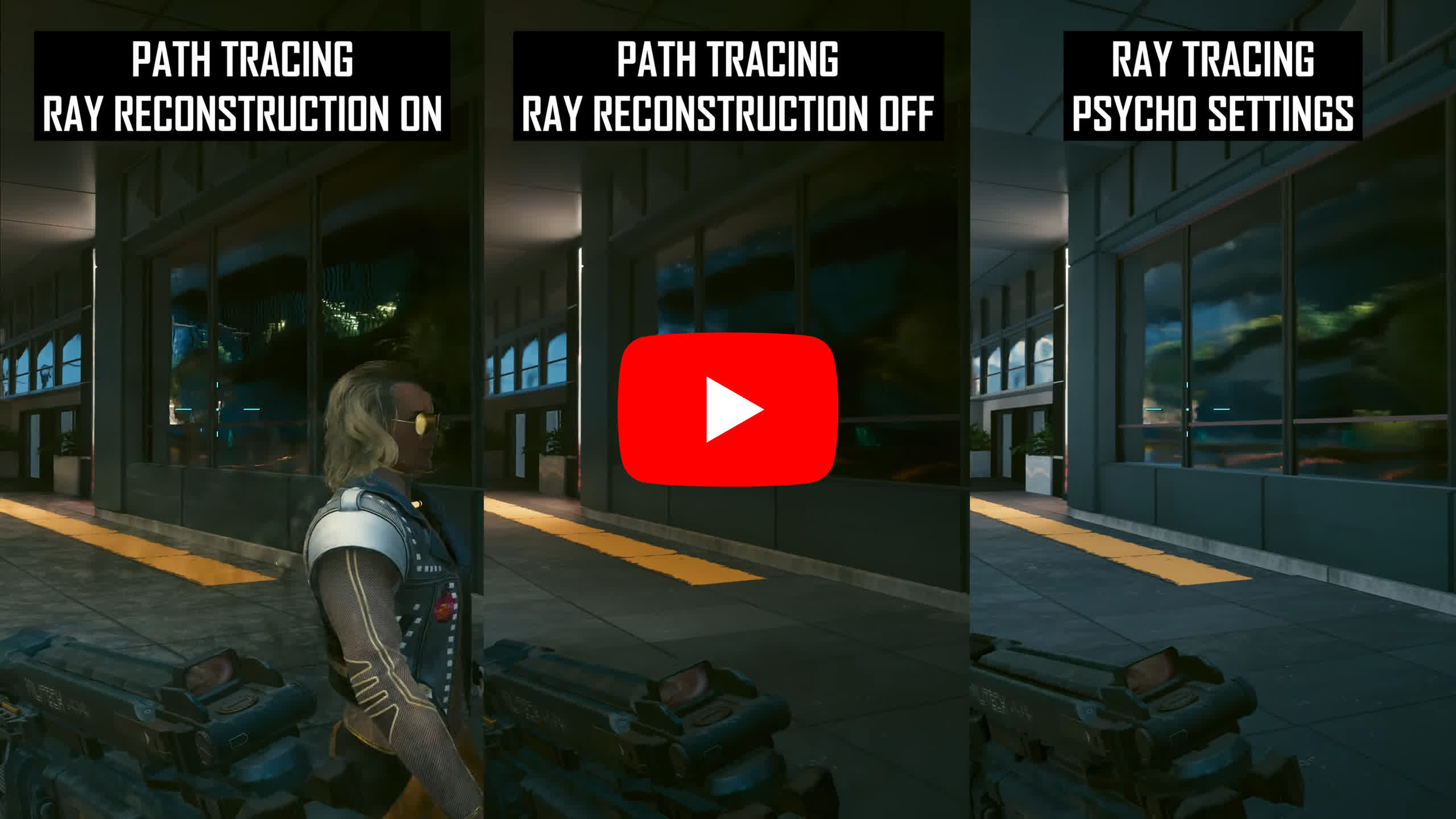
For ray traced reflections on highly reflective surfaces, ray reconstruction is able to denoise these effects to produce a higher apparent resolution. In some scenes it produces a noticeably higher reflection quality compared to the path traced mode without ray reconstruction, and the regular ray tracing mode.
The ray reconstructed image is sharper and clearer, both stationary and in motion. It’s a shame this tech isn’t available with the regular RT mode as I think it could benefit from it just as much as we are seeing in the path traced mode. It’s not subtle and makes ray tracing a more worthwhile effect to enable.
Ray reconstruction also improves the temporal accuracy of reflections. The path tracing mode by default clearly uses a temporal denoising filter that works over a long period of time. When you move around and stop while viewing a reflection, it can often take a few seconds for the final reflection to “settle” into place, with the reflection appearing to move when it shouldn’t be. Ray reconstruction significantly shortens that settling period and almost removes this temporal artifact.
This brings the ray traced image much closer to the responsiveness of the game’s non ray traced screen space reflections. While the screen space reflections are also of a higher apparent resolution at times, they have some… pretty significant limitations in motion, like disappearing entirely.
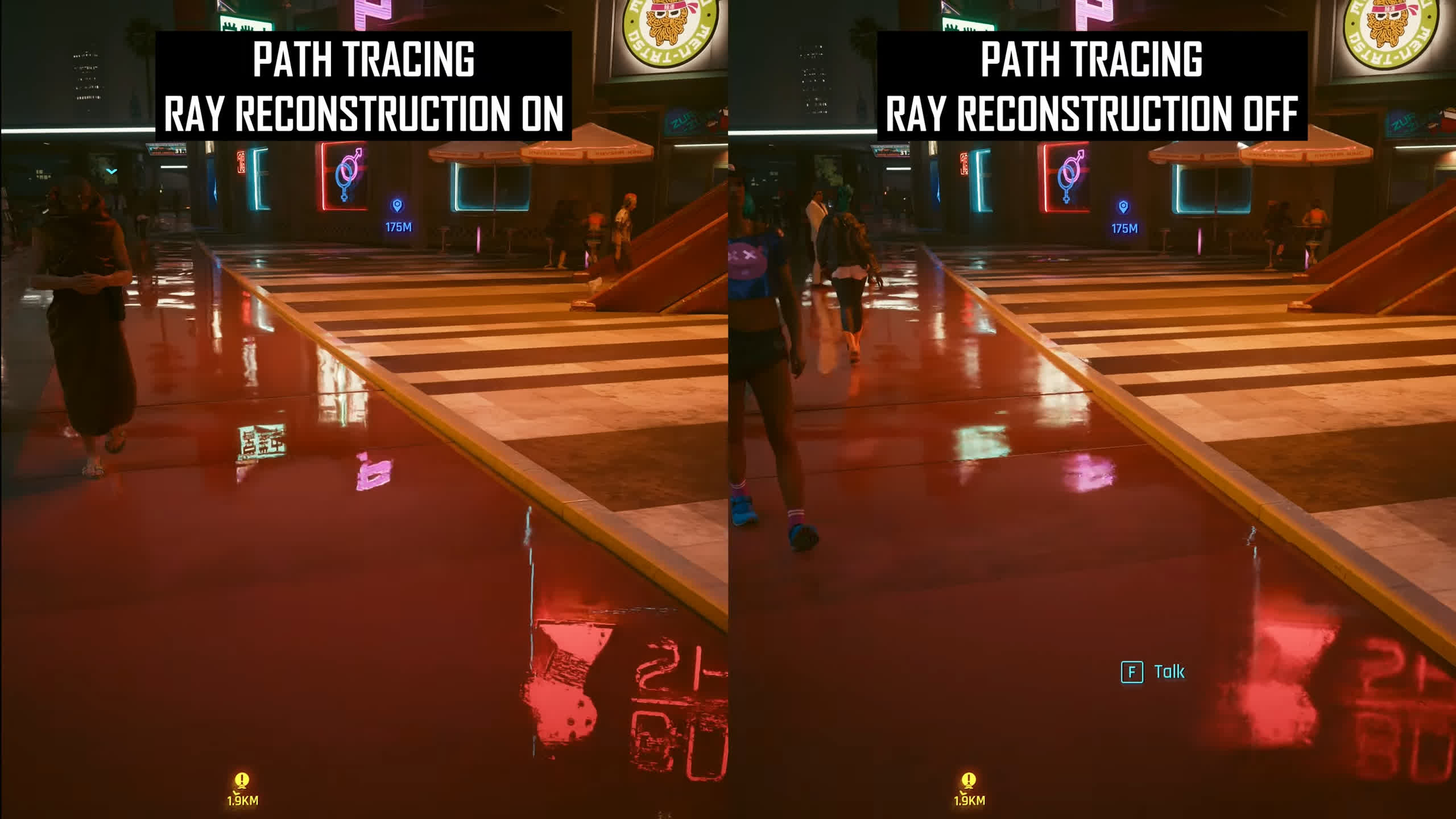
At times at night we see a combination of these improvements to reflections, though this isn’t always this case. The scene above has a higher reflection resolution, reduced reflection ghosting and reflections that are more responsive to motion when ray reconstruction is enabled. Ray reconstruction also handles the actual denoising part better for some more diffuse reflections.
Not all reflections are enhanced by ray reconstruction though. In some examples we saw reflections in transparent glass. Both with and without ray reconstruction enabled, the clarity of reflections is excellent either way, so for this type of effect, enhanced denoising is not necessary.
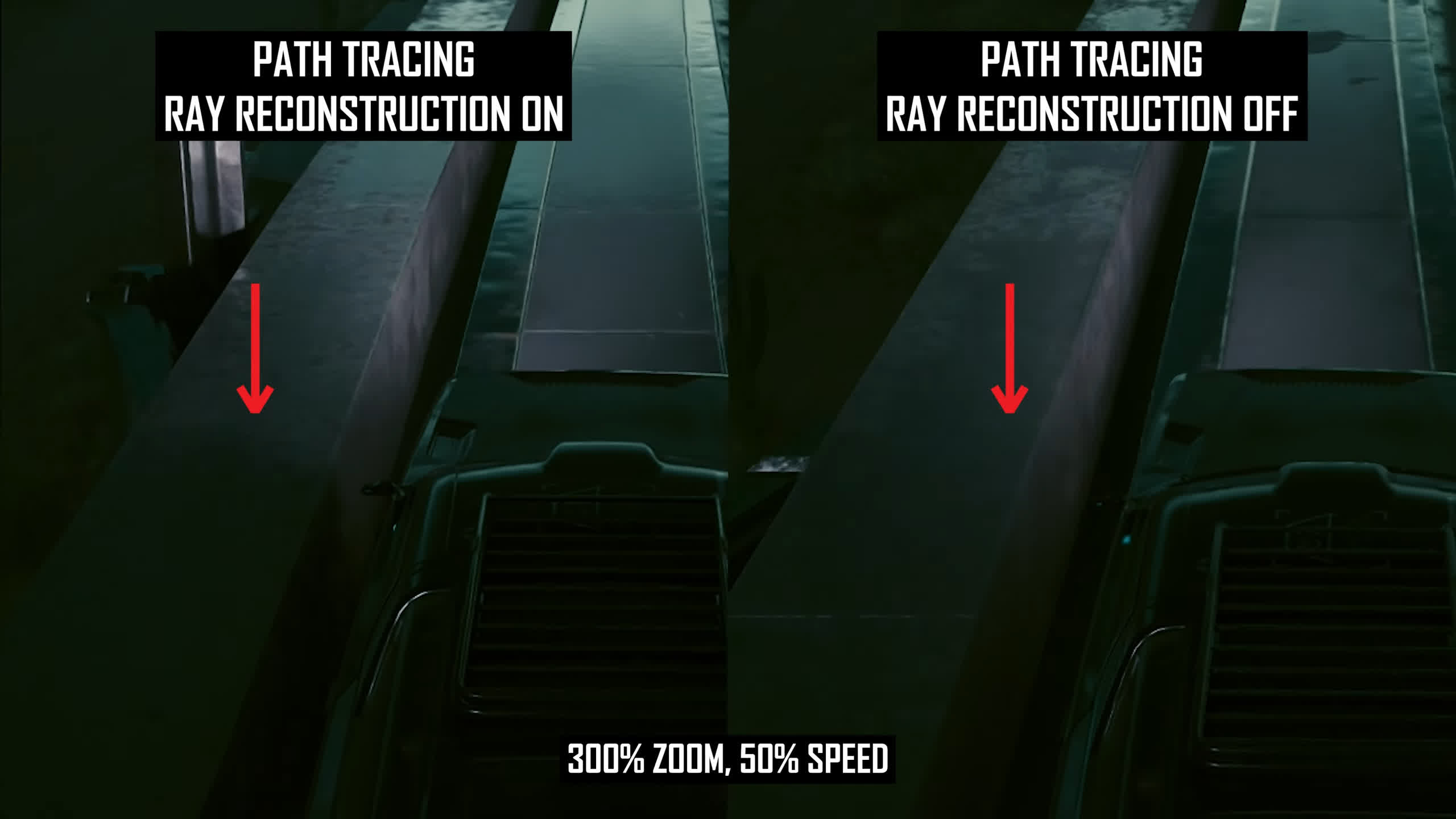
It’s not just reflections that ray reconstruction improves though. When assessing shadow quality, ray reconstruction produced less noisy shadows in motion, it’s a subtle effect that’s not as noticeable as the improvements to reflections – and generally the responsiveness of shadows in motion is a lot better than reflections – but ray reconstruction did appear a bit sharper.
On top of improved noise reduction, ray reconstruction provided more accurate car headlights with reduced smearing, ghosting and blur. With the normal path traced mode, car headlights lack definition in motion and almost appear like a blob of light at the front of the car – sometimes with light appearing before the actual position of the headlight, an effect of temporal denoising. With ray reconstruction enabled, the light emitted from the headlight is more defined and less likely to appear before its actual position, improving the accuracy of this effect.
Global illumination and ambient occlusion are also improved through ray reconstruction. Ambient occlusion improvements are subtle, though various scenes do look different with ray reconstruction on.
For a better representation of image quality comparisons, check out the HUB video below:
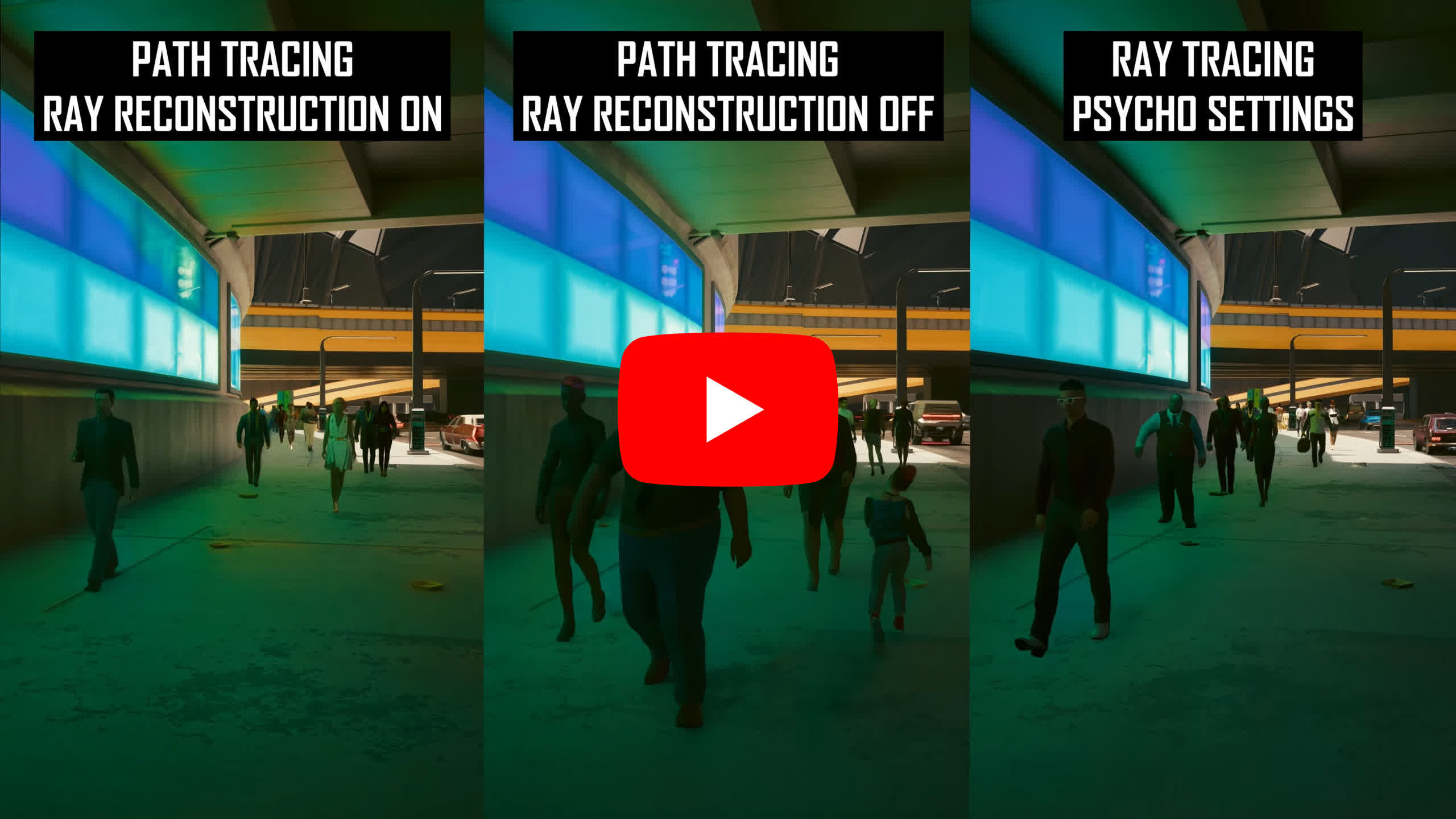
The scene above is one of the weirder ones we found for image quality. Here we have a light panel that illuminates concrete above and below. With all three ray traced modes: the normal RT Psycho mode, RT Overdrive without ray reconstruction, and RT Overdrive with ray reconstruction; it takes a brief moment for the color change of the light to impact the global illumination seen here. ray reconstruction doesn’t solve this delay, there’s still an unnatural disconnect.
However when the colors do change, without ray reconstruction you get this ugly transition between colors that’s especially noticeable around the moving pedestrians. It’s this weird color ghosting effect and it happens between every color. With ray reconstruction, some color transitions occur instantly without this ugly ghosting, like purple to yellow, or blue to purple. Other colors see some but reduced ghosting, like yellow to green. Quite a bizarre discovery.
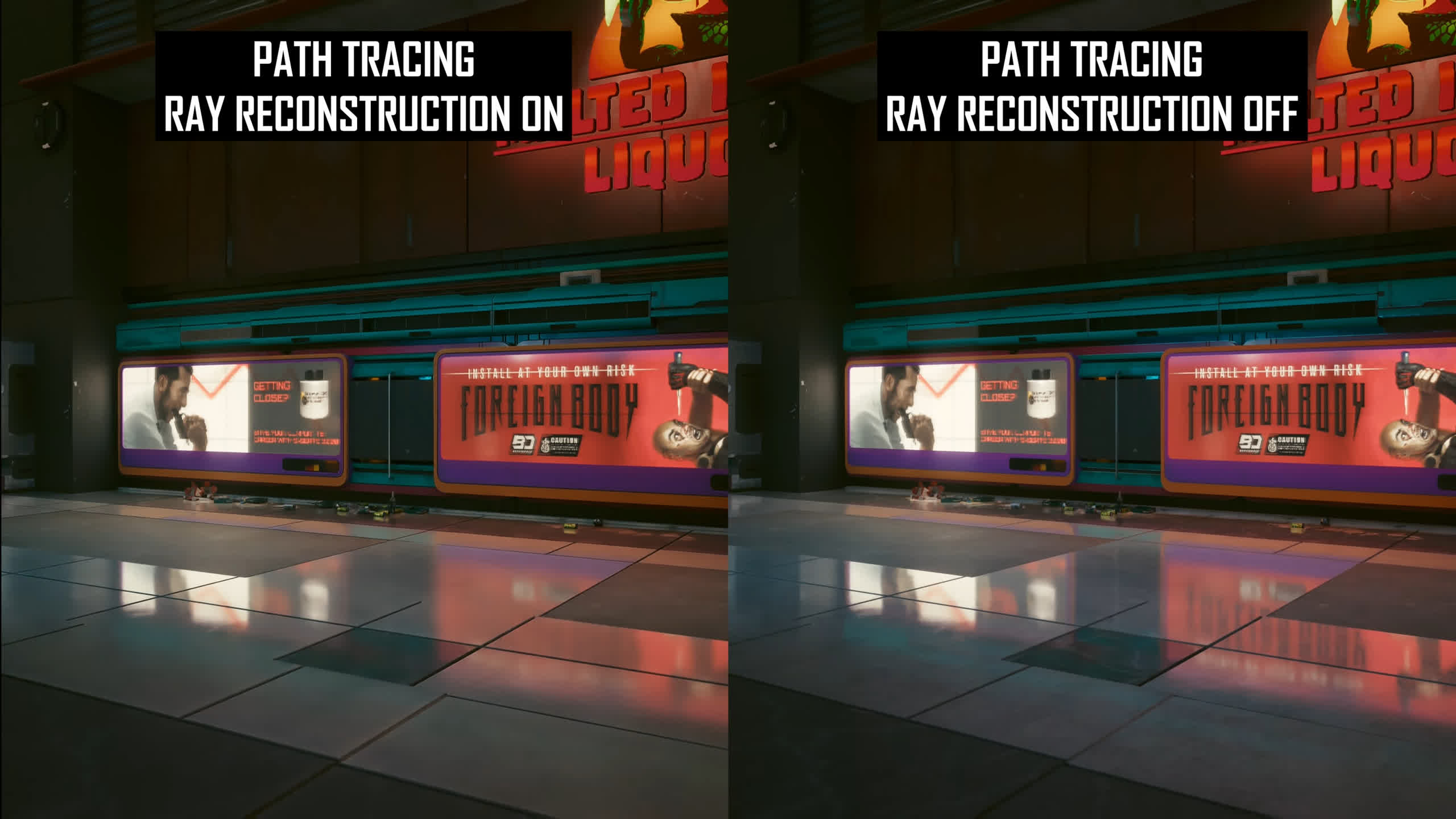
Unfortunately ray reconstruction doesn’t always look better when it’s enabled. The technology struggles with some specific types of reflections, usually when it’s a semi-reflective, not as shiny surface with texturing. Take the scene above as an example which has this marbled concrete tiling on the ground. The path traced mode without ray reconstruction produces a clearly higher resolution and more defined reflection. It’s a stark difference, too, to the point where we were sure we were getting the settings messed up. But nope, we’ve tripled checked and this is indeed labelled correctly.
When we add motion to the mix, the ray reconstructed image also has worse ghosting and stability. It seems to be the case where the ray reconstruction algorithm isn’t quite sure whether what it’s seeing is a reflection or not, and ends up handling both the reflection and the texture applied to this surface rather poorly.
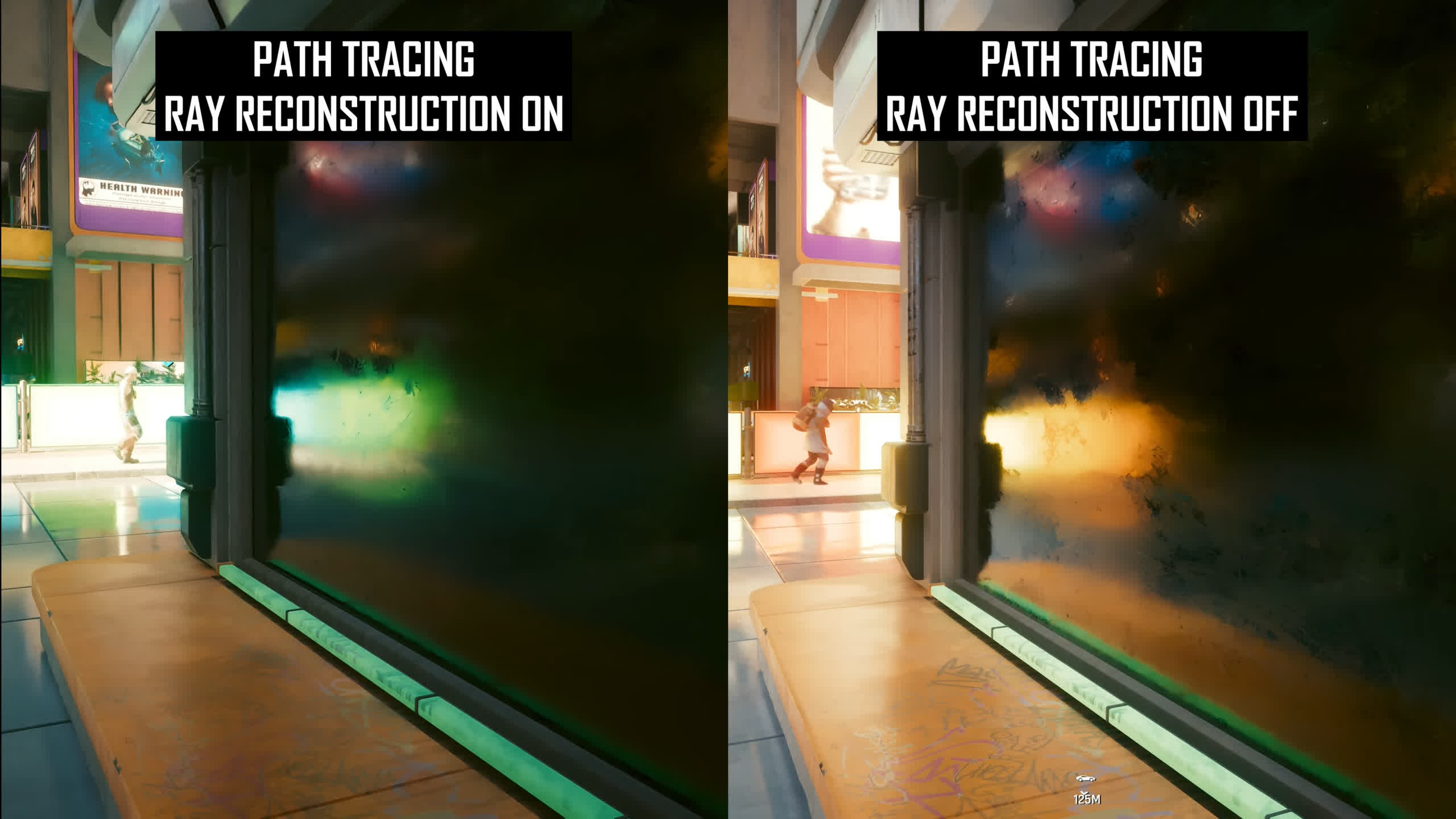
And finally here is perhaps the clearest example of the strengths and weaknesses of these types of reflections. When we start further away from this glassy surface, ray reconstruction is able to produce a better quality reflection.
When walking towards the surface, after a certain point a texture loads in across the glass, it’s smudgy and has a lot of scratches and stuff. After this point, the non ray reconstructed image better preserves this texture and produces a higher detail image.
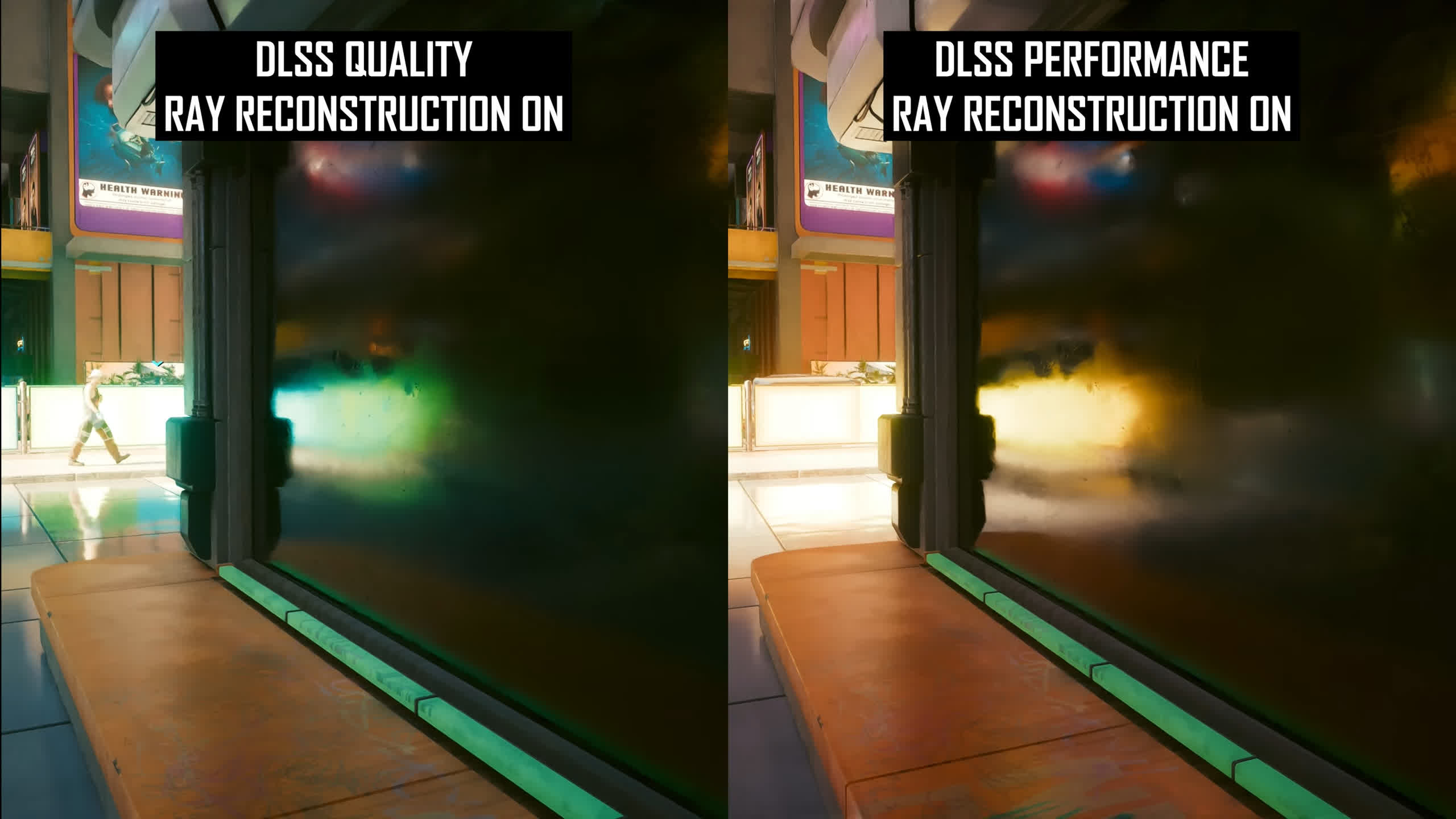
Also, as expected, with a lower render resolution, not only does general image quality get worse, but so does the sharpness and clarity of ray traced effects. Still, even with DLSS Performance being used, we still get most of the benefits of ray reconstruction, so reflection quality as one example doesn’t become worse than not using ray reconstruction, it still ends up looking better despite the lower render resolution.
DLSS 3.5 ray reconstruction performance
There’s lot a lot to say when it comes to performance. When testing using the GeForce RTX 4090 across multiple resolutions and DLSS quality modes, ray reconstruction has little impact to frame rate whether it’s enabled or disabled. On the RTX 4090, having the setting off was slightly faster in the area we tested, but even then we’re talking about up to a 4% difference, with a typical margin around 1% which is effectively margin of error type stuff. Given that it generally provides superior image quality, it’s nice to see this setting has little impact to performance.
DLSS 3.5 Performance
This is also true when looking at the setting across a range of GPUs, here we have four models tested at 1440p using the DLSS Quality mode. While the RTX 4090 was slightly faster without ray reconstruction, the other models were all slightly faster with ray reconstruction enabled.
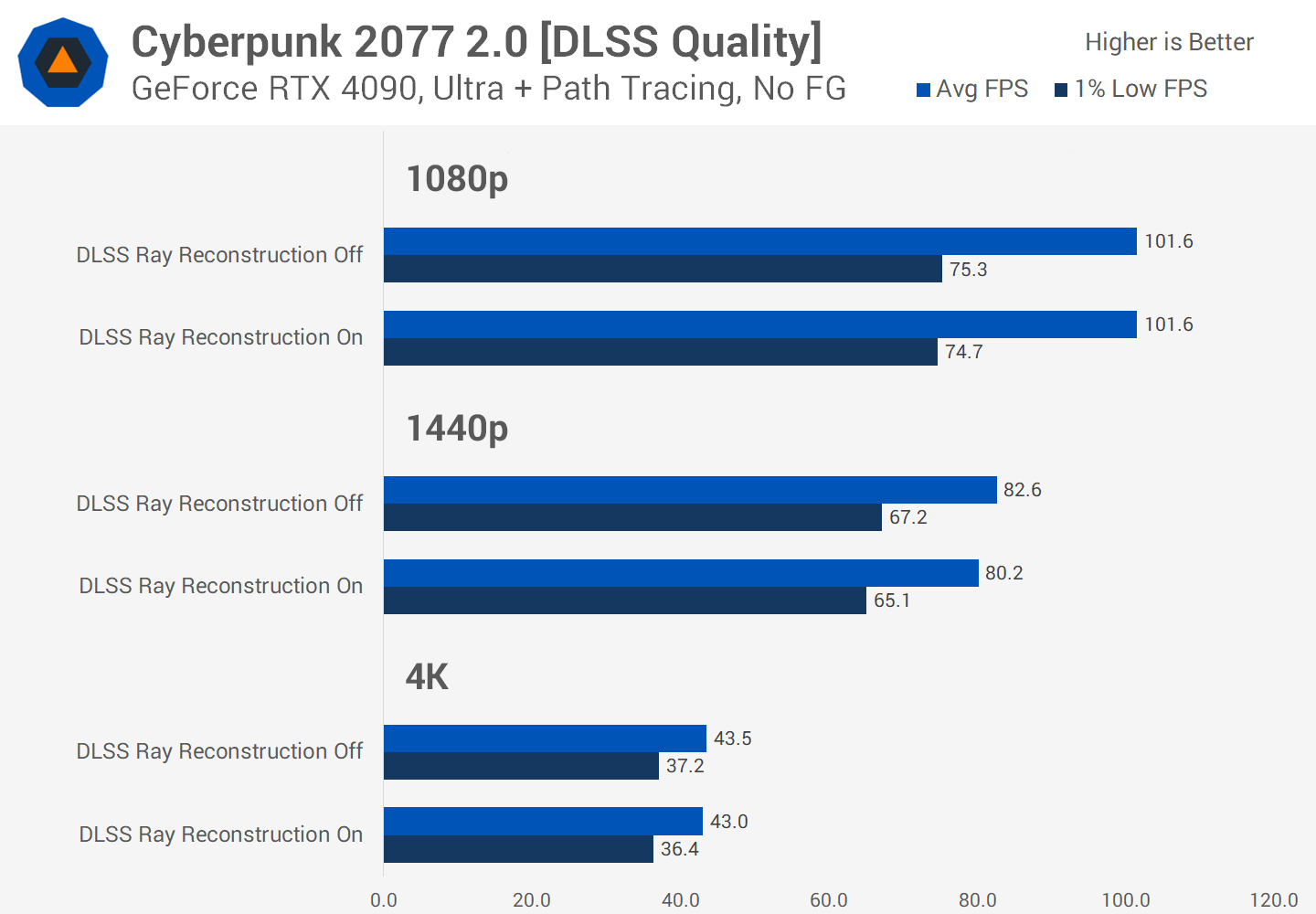
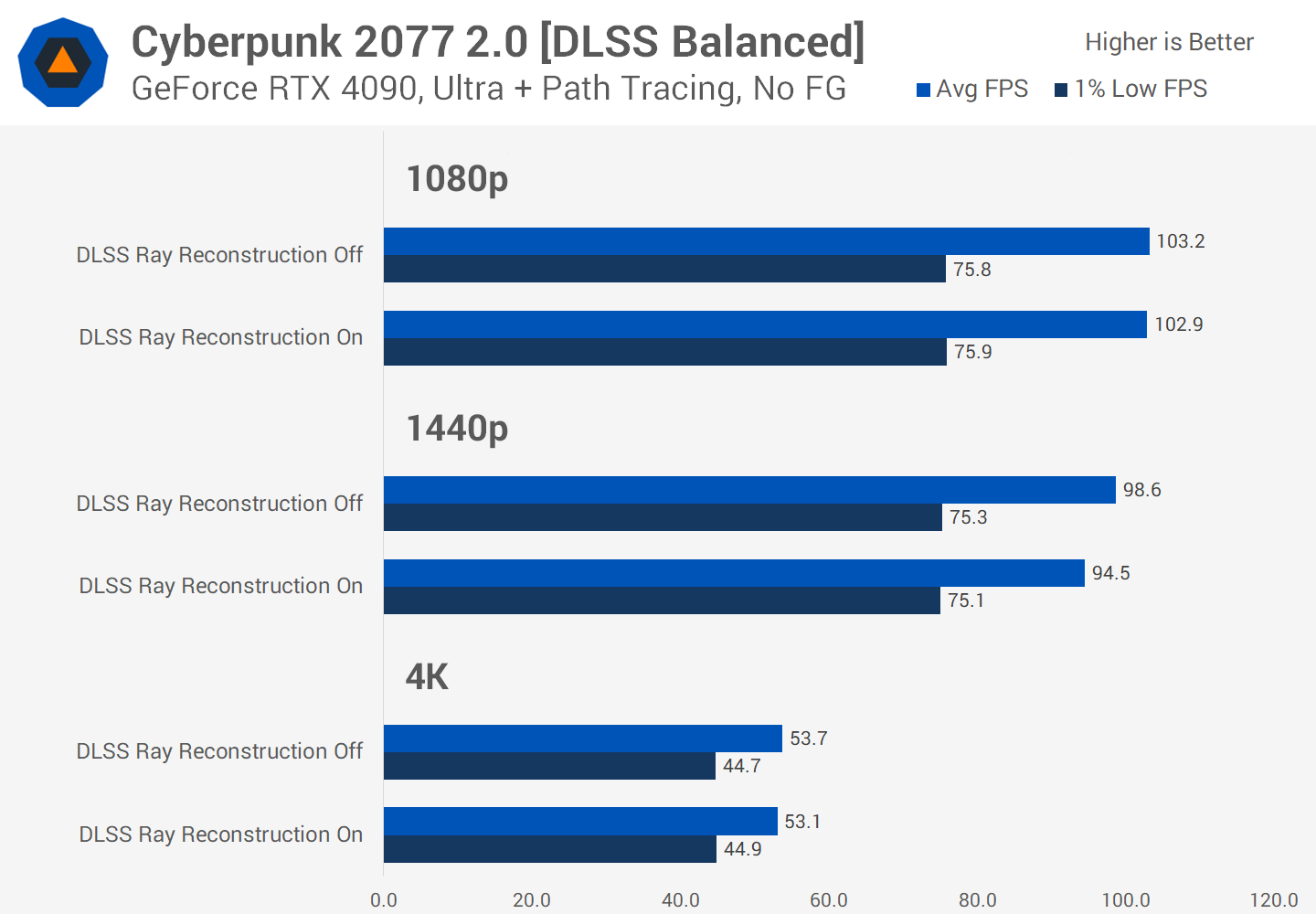
Best case, we saw a 7% win for ray reconstruction with the RTX 4070. By the time we got to the RTX 3070, this card is simply too slow for path tracing at 1440p, so performance is largely identical either way.
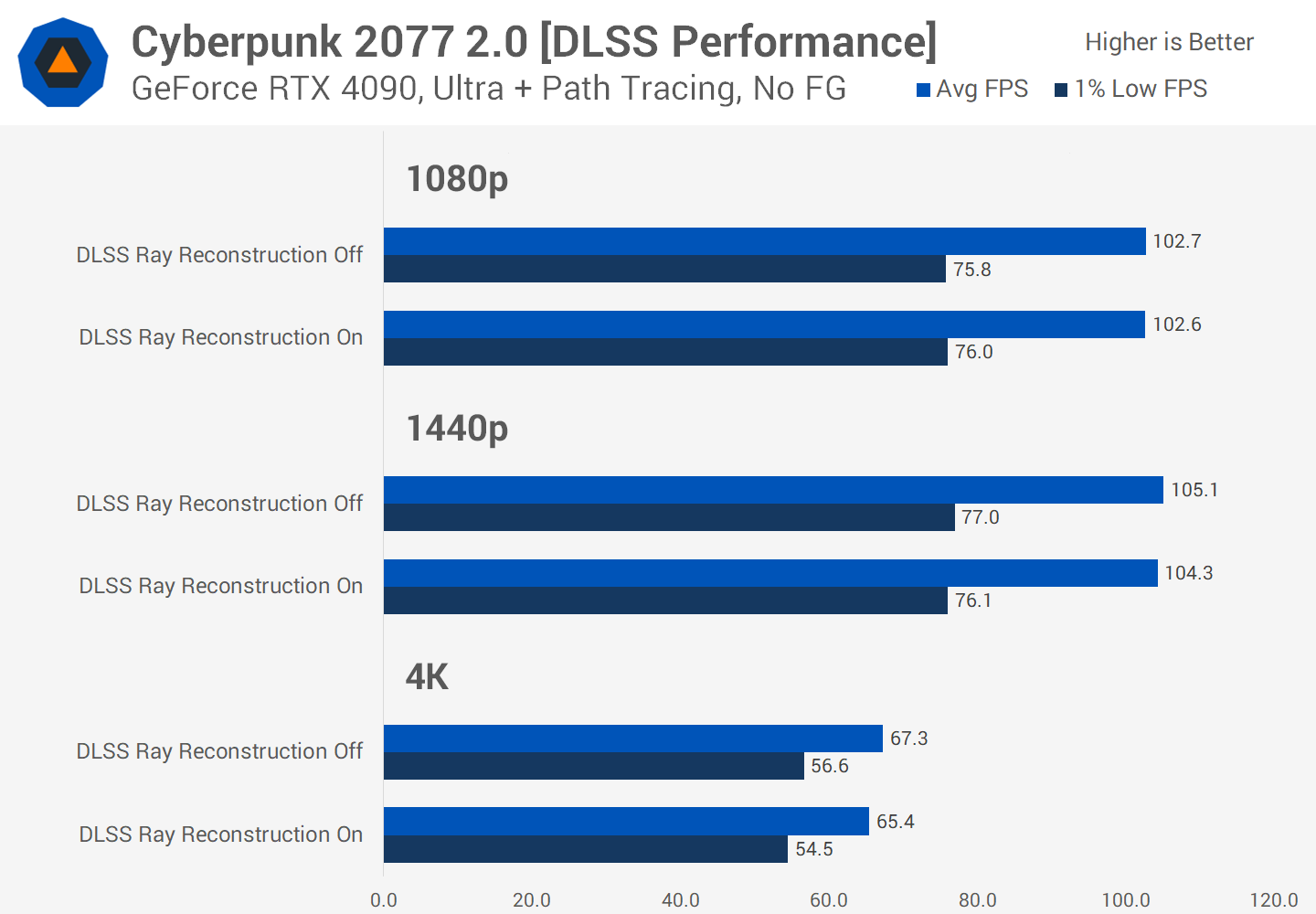
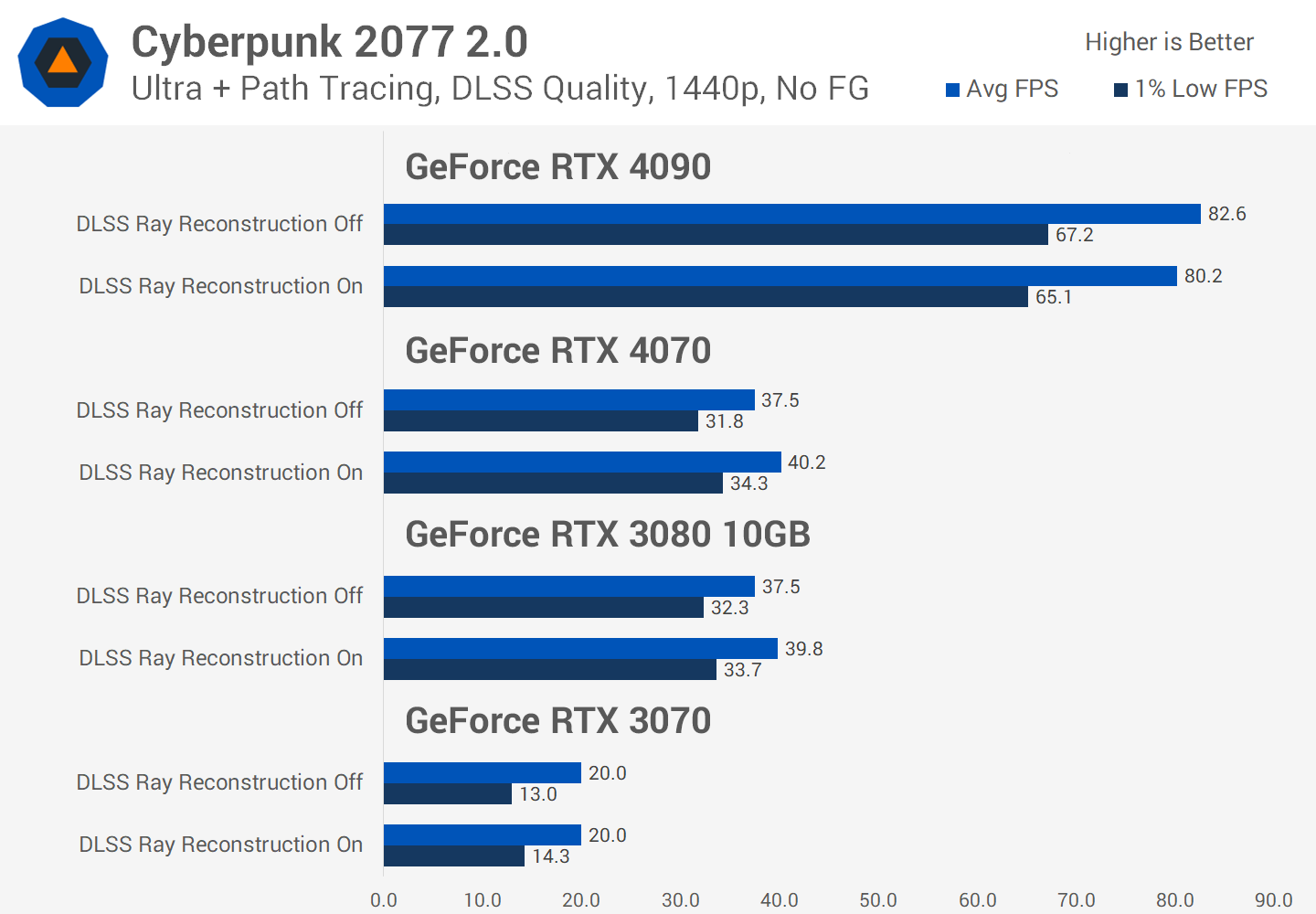
At 1080p again most of these lower tier cards really aren’t capable of path tracing, though generally the ray reconstruction mode is slightly faster. It’s not an earth shattering margin, we’d typically call this a tie which is a good result for better image quality on the whole.
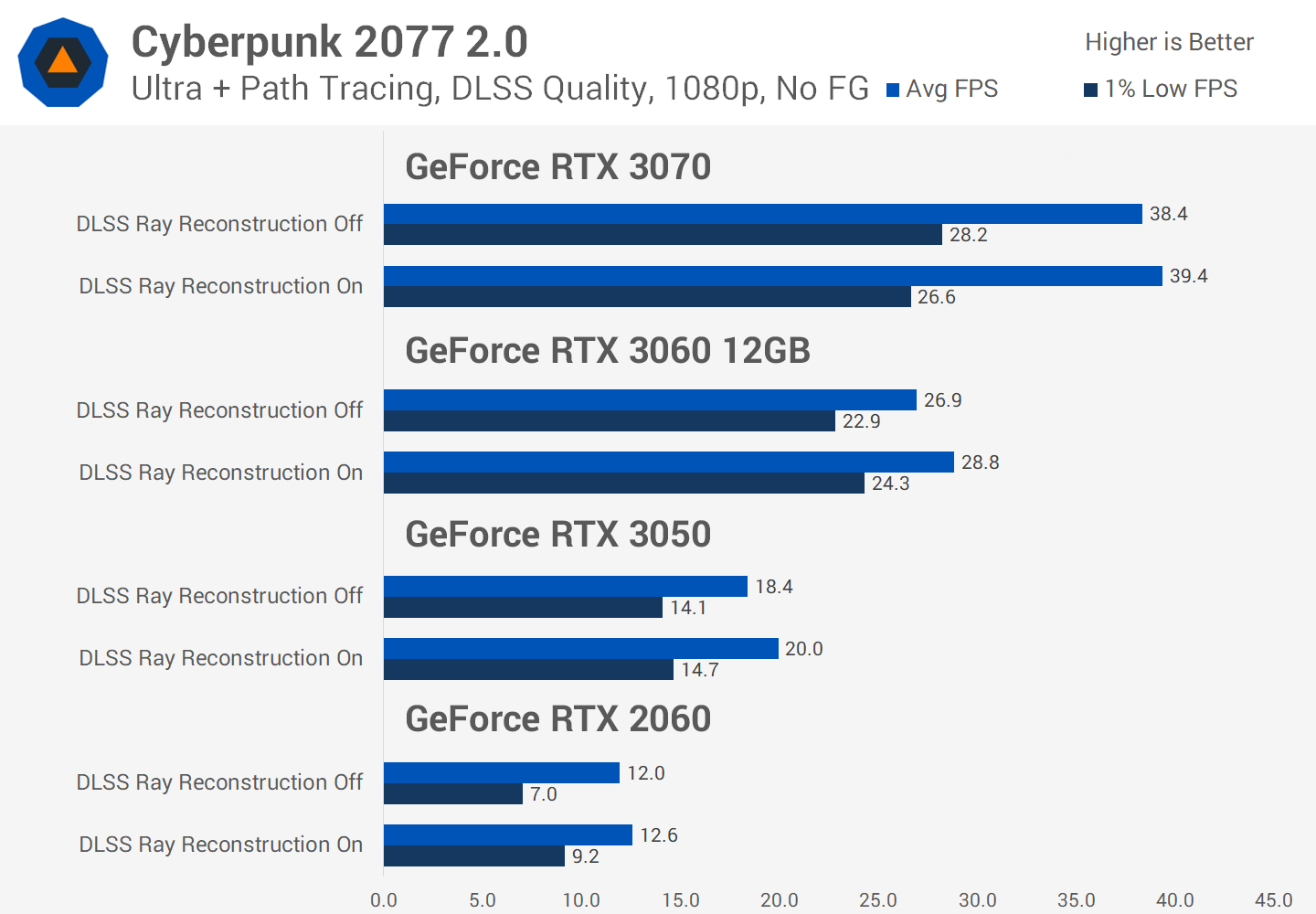
What We Learned
Overall, we’re reasonably impressed with this first look at DLSS 3.5 ray reconstruction in Cyberpunk 2077. With no impact to performance, ray reconstruction typically improves image quality for ray traced effects in a number of ways: higher fidelity reflections and shadows, a less noisy image in motion, a more responsive image in motion with a much shorter settling time for effects, reduced ghosting, and improved accuracy for lighting resulting in greater image definition.
For the most part, this solves several issues we’ve had with ray tracing over the years. In many games, when you enable ray traced effects, surely we can see more impressive reflections that look more accurate and work properly in more situations. But this has often come at a cost of a lower effect resolution, a more grainy image, more artifacts and less temporal responsiveness.
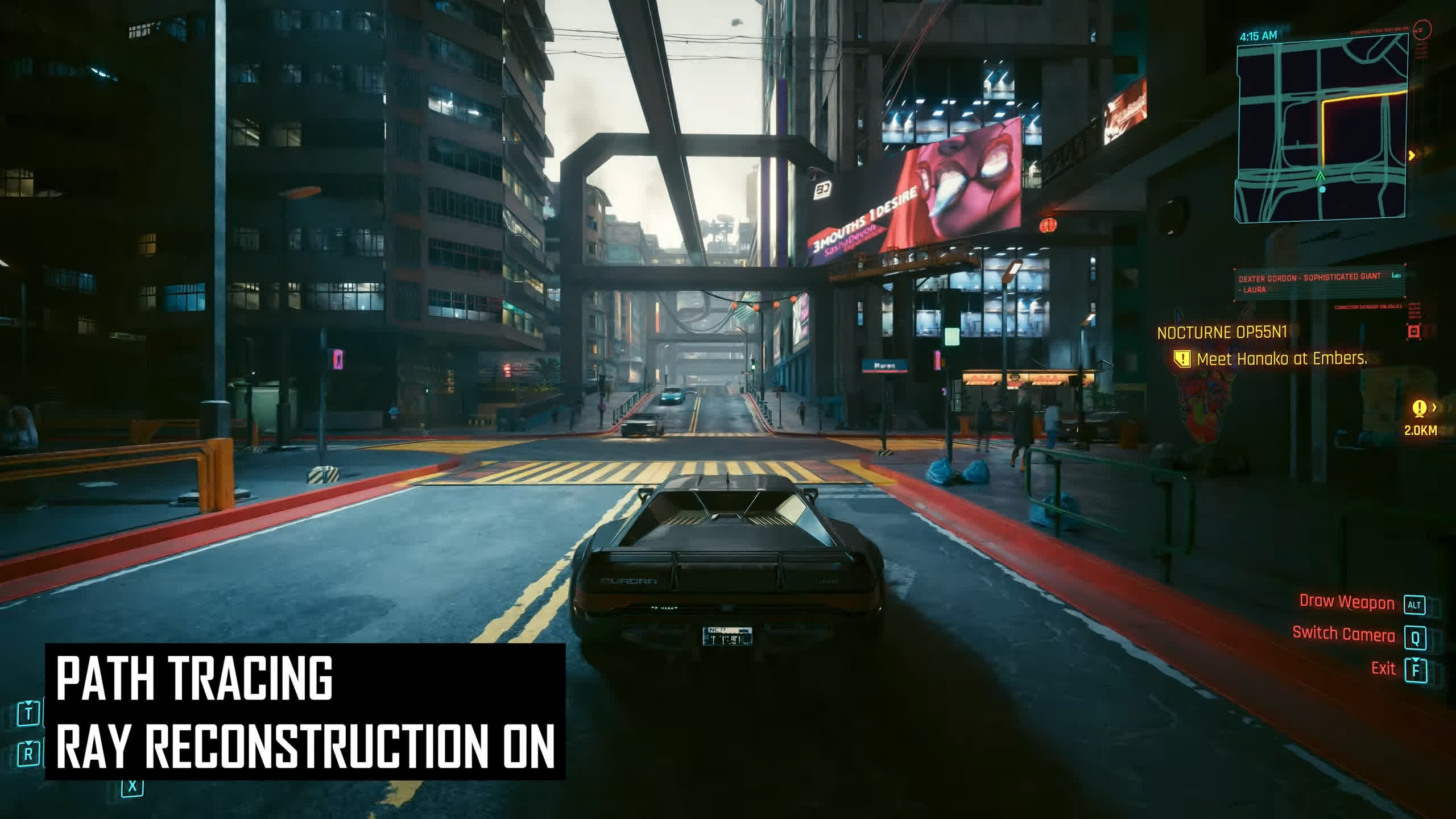
Sometimes ray traced effects will boil, sizzle and move even when there’s no actual motion on screen, a byproduct of very low ray counts and weak denoisers. There are times we haven’t wanted to play with ray tracing on because these issues are so noticeable and annoying and really don’t justify the huge performance hit.
Ray reconstruction is a step towards fixing this kind of problems, making ray tracing much more usable. We’re more likely to enable ray tracing in a game when the image quality is genuinely impressive, when there’s not many artifacts or issues, and when the performance hit is visually justified. This technology seems like a suitable way to reduce artifacts and improve ray tracing quality without needing to increase ray counts and make the performance hit even larger.
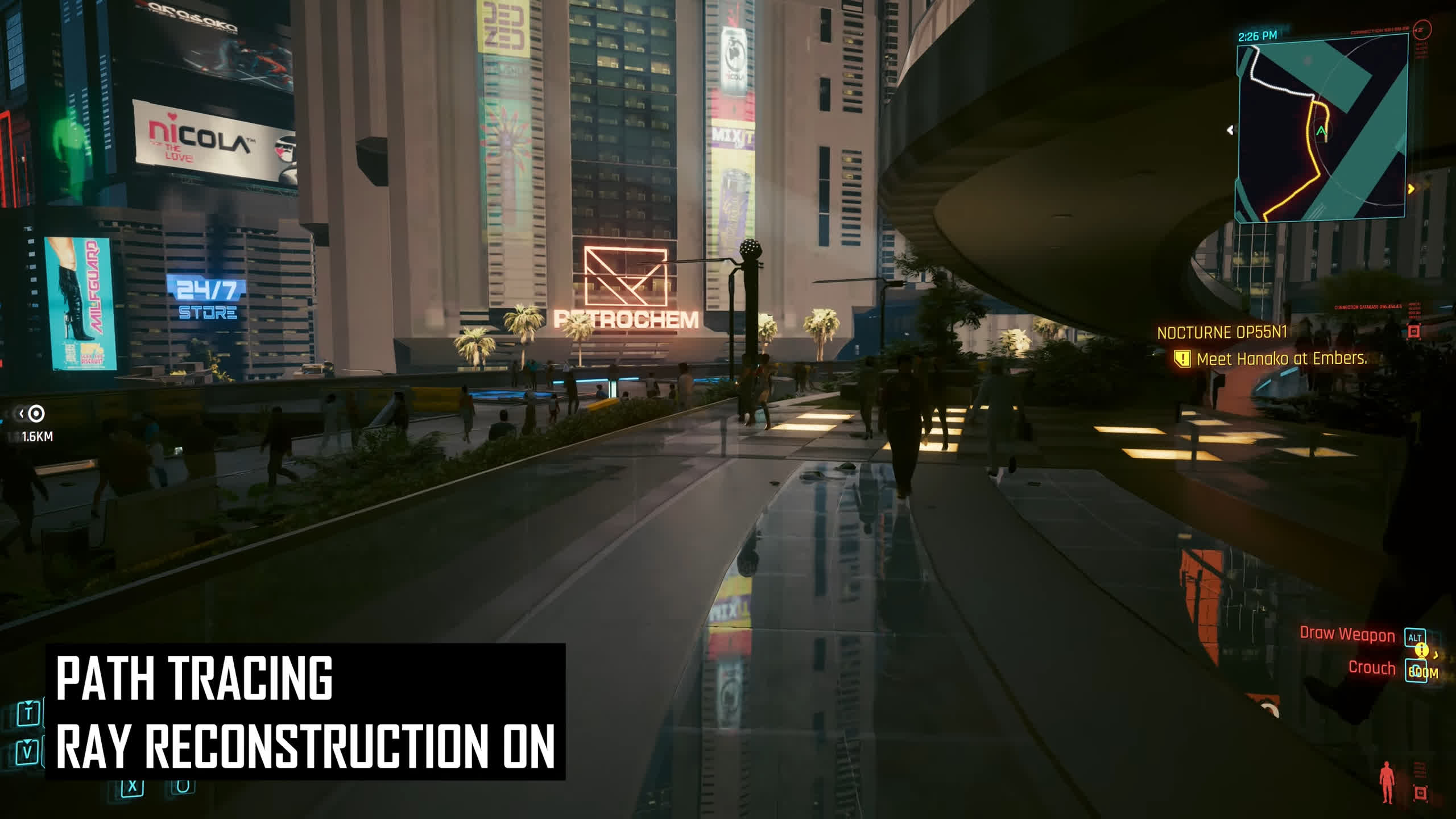
We’re also hopeful that ray reconstruction will encourage developers to use more intensive ray tracing effects because the resulting quality will actually justify the performance cost. It’s clear that some developers are being conservative with ray tracing to the point where the visual difference is negligible with it enabled, all because they don’t want to cause a massive hit to performance.
Ray reconstruction doesn’t reduce the performance hit from enabling high quality RT effects, but it makes them easier to justify because the final image quality is more acceptable than it otherwise would be. However, ray reconstruction clearly still has some issues and Nvidia has a long way to go before this feature is a slam dunk win for improving ray tracing.
In several areas we saw ray reconstruction cripple image quality, as it does seem to struggle with some types of reflections on textured surfaces. This isn’t something you’ll see all the time, it’s highly dependent on the surface, lighting, location, time of day, and so on, but it was obvious at times across many hours testing Cyberpunk.
If we had to put some numbers to it, we say that ray reconstruction improves image quality about 60% of the time, ~20% of the time there is no impact, and ~20% of the time we see a regression.
If we had to put some numbers to it, we say that ray reconstruction improves image quality about 60% of the time, ~20% of the time there is no impact, and ~20% of the time we see a regression. However Nvidia does have a proven track record of improving DLSS quality over time through updates – we’ve seen that with Super Resolution and Frame Generation. Nvidia also acknowledged that there are certain scenarios where ray reconstruction would benefit from additional AI training, so we’ll be keeping an eye out for improvements over time.
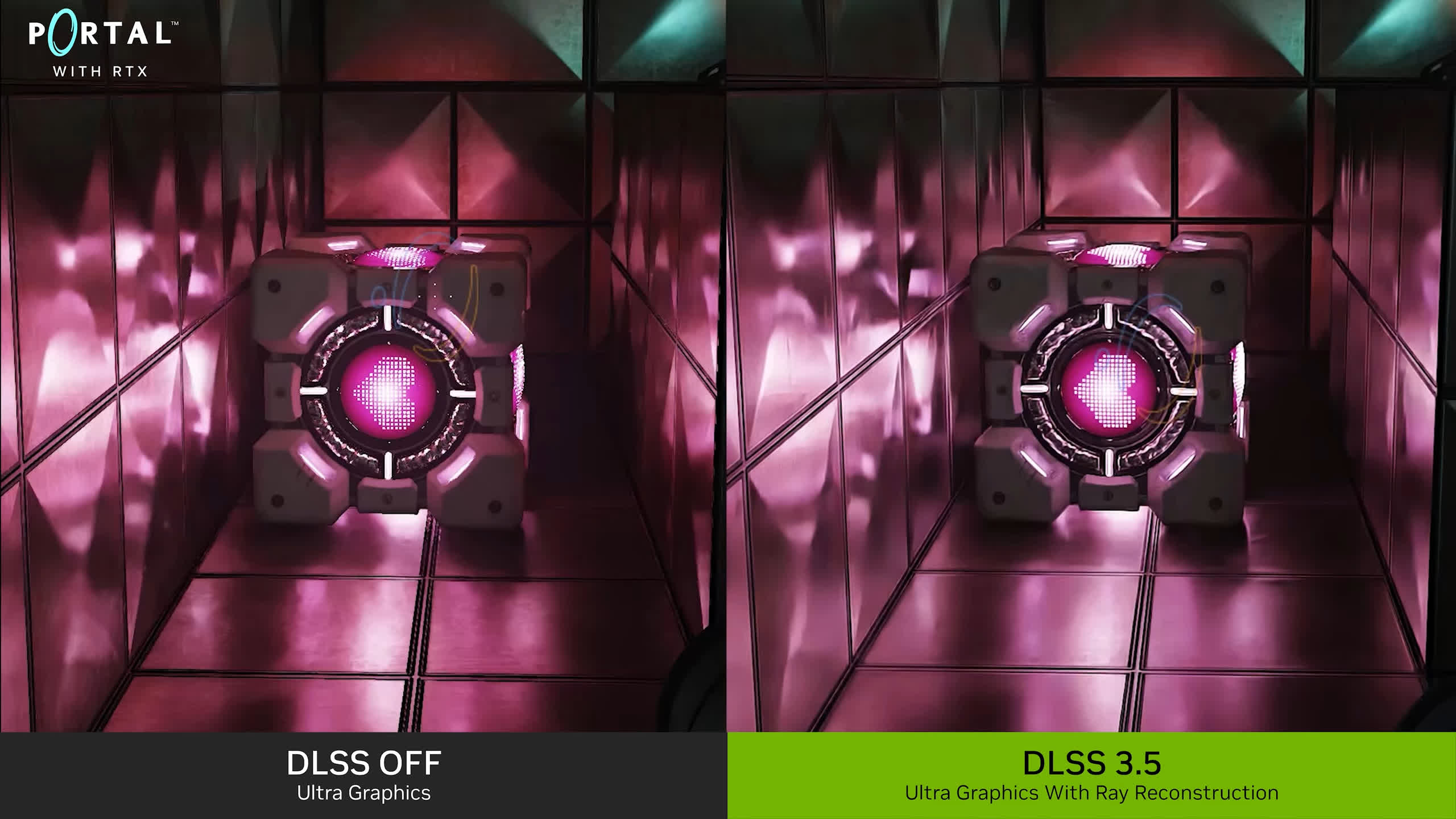
What also leads us to believe that this is an early, perhaps even rushed implementation and that’s why ray reconstruction is not available for the regular ray tracing modes, when they would clearly benefit from superior denoising and greater image quality.
Having it working with the most intensive path traced mode is nice, but the majority of RTX owners don’t have the GPU power for path tracing. It’s barely viable on an RTX 4070 or RTX 3080, the latter of which doesn’t even have the crutch of Frame Generation. Once we get to GeForce models priced at $500 or less (or the entire Turing generation), at best you’ll be using the normal ray traced modes, which currently aren’t compatible with ray reconstruction.
Nvidia and CDPR need to get the feature working with regular ray tracing, so the majority of GeForce owners can benefit, and so that DLSS 3.5 can truly live up to its compatibility claims across all RTX GPUs, because right now that’s just on-paper support. In addition, supporting DLAA would be nice, although DLAA with path tracing is pretty crippling even on an RTX 4090.
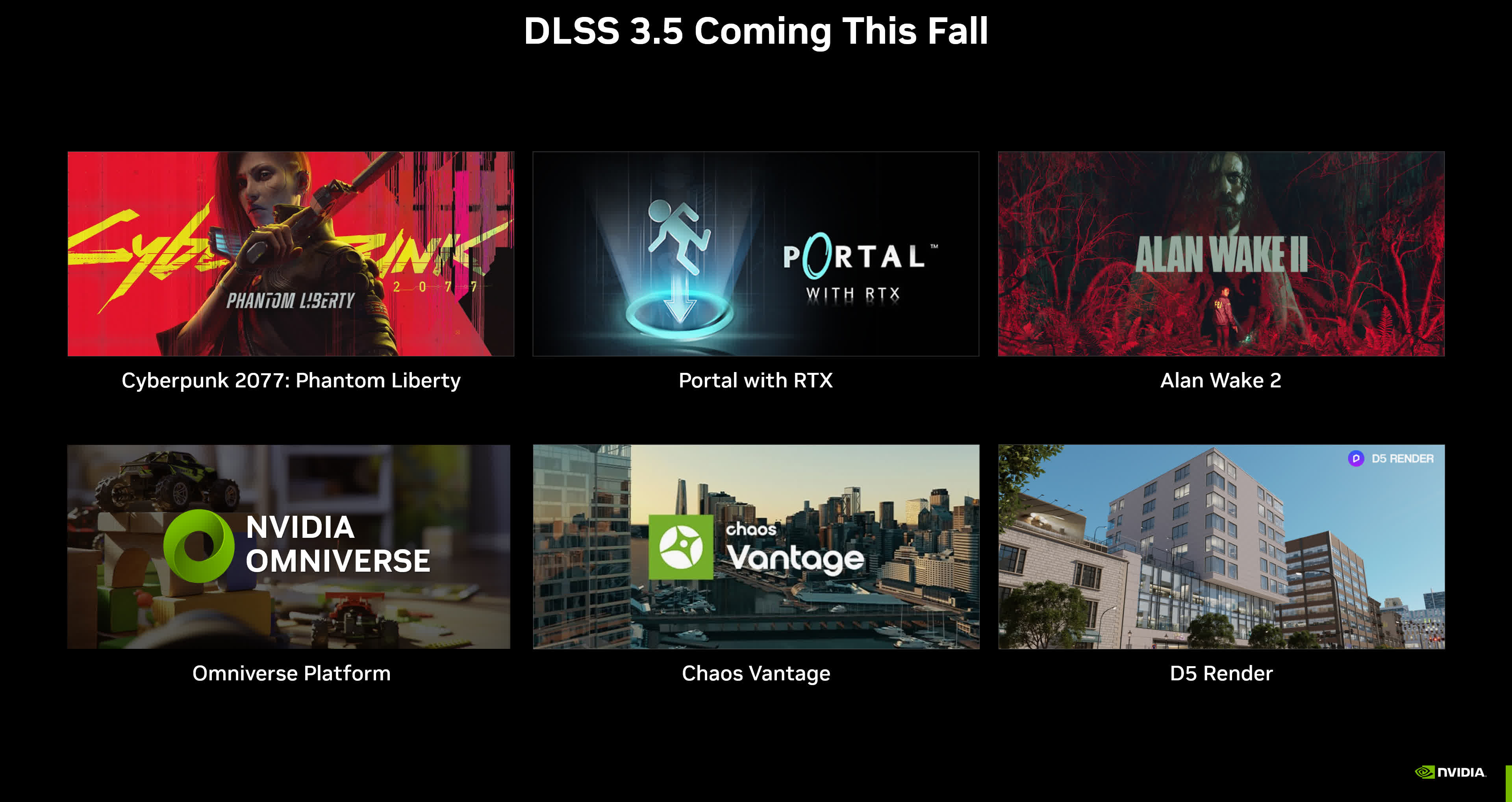
Once again, this is an early look of the technology based on testing with just one game. DLSS 3.5 ray reconstruction replaces the ray tracing denoiser in the game, so the benefit over standard image quality will vary depending on how good the game’s traditional denoiser is. It’s possible that games with excellent denoisers will benefit less from ray reconstruction, while those with garbage denoisers or poor implementations will benefit more. Over time we’ll get a better idea of the general impact in games, although this initial look is reasonably impressive and we’ve yet to see many (or any) examples of games with superior ray tracing effect quality than what DLSS 3.5 is providing.
At present, ray reconstruction is not a selling point to purchase a GeForce GPU. Game support, even in upcoming titles, is very limited and Nvidia has plenty to work on to improve the feature. But AMD and Intel should be working on a competing technology right away, because neither will want to fall behind in ray tracing image quality over time if ray reconstruction takes a hold across a large number of games. AMD in particular shouldn’t want to be the brand where not only does ray tracing perform worse on their products, but looks worse as well.
Shopping Shortcuts:
Denial of responsibility! My Droll is an automatic aggregator of Global media. In each content, the hyperlink to the primary source is specified. All trademarks belong to their rightful owners, and all materials to their authors. For any complaint, please reach us at – [email protected]. We will take necessary action within 24 hours.

